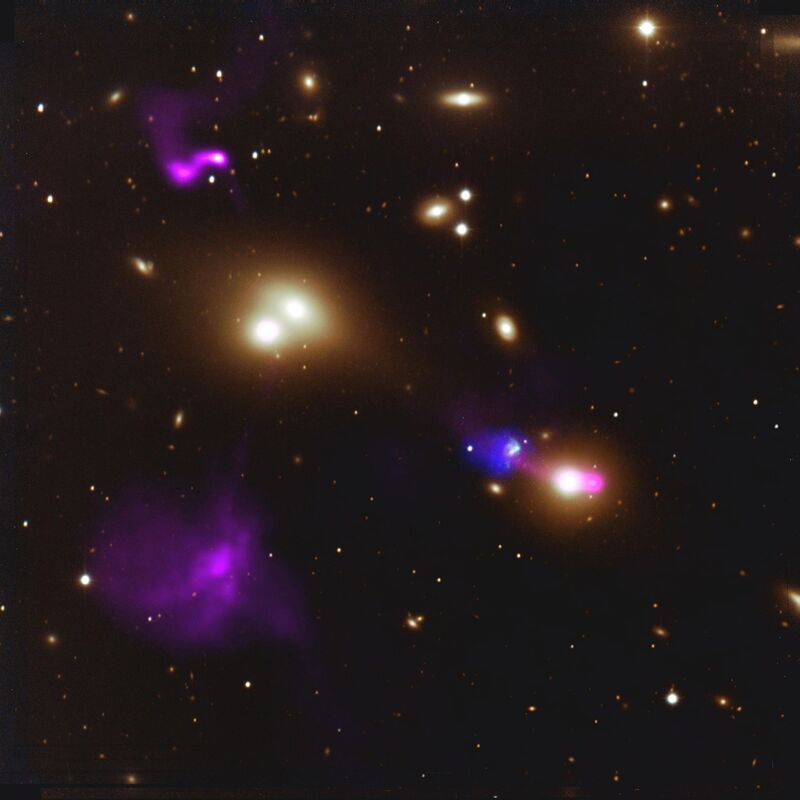Star Birth Triggered by a Jet from a Black Hole
Description
This image of the cluster of galaxies known as Abell 194 shows two radio galaxies shooting out huge, powerful jets of material from the regions surrounding the black holes at the galaxies' centers. These jets are visible in the radio data from the VLA telescope, shown in purple, overlaid on the color image of the cluster from the Lick Observatory 120-inch telescope. The jets from the interacting galaxies known as NGC 545 and NGC 547 (center left) extend for some 250,000 light years (one light year is around 6 trillion miles - the distance light travels in one year). The shorter jet from the galaxy NGC 541 (lower right) collides with a cloud of hydrogen gas, shown here in dark blue (also detected via its radio emission using the VLA). The pressure from the jet triggers the collapse of blobs of gas within this cloud, which form stars (seen in the light from excited hydrogen atoms, which are shown in this image as a light blue overlay from data from the 2.3-m telescope at Siding Spring in Australia). This unusual star forming system is known as Minkowski's Object, and is an example of black holes bringing new life (in the form of baby stars) to the Universe, when cosmic collisions between their outflowing jets and surrounding gas trigger the gas to collapse.
This image of the cluster Abell 194 (Lick 3-m PFCam B+R) shows the radio galaxy 3C40 (left) associated with the interacting system NGC 545 / 547, and the radio galaxy NGC 541 (right), with combined B-array (1984 Jan 08) and C-array (1984 Jun 02) L-band continuum data shown in purple. Overlaid in light blue is H-alpha data from the Siding Spring 2.3-m telescope, and H-alpha emission can clearly be seen from Minkowski's Object, a peculiar system which lies in the path of the jet. HI observations (2004-04-02, L-band, C-array) are shown in dark blue, clearly illustrating the large cloud of HI which surrounds Minkowski's Object. The HI is divided into two clumps, with the jet passing straight through the middle. Downstream of the HI cloud, the jet decollimates. This system provides an excellent example of positive feedback from radio galaxies in the form of jet-induced star formation.
Creator
Legacy Astronomical Images
Rights
NRAO/AUI/NSF does not hold full copyright for this image. Contact the archivist for details.
Type
Legacy Astronomical Image
Object Name
Minkowskis Object
Photo Credit
Courtesy of S.Croft, W.van Breugel, W. de Vries, J.van Gorkom, H.Morganti, T.Osterloo, M.Dopita, M.Gregg
Investigators
Wil van Breugel, et al
Telescope
Very Large Array (VLA)
Observation Date
1984-06-02
Type of Observation
continuum
Band
L
Wavelength
20 cm
Frequency
1.4 GHz
Center of Image
RA 1:25:53.400, Dec: -1:21:38.800 (J2000)
Field of View
0.180000 x 0.180000 degrees
Link to journal article
Notes
Contact the archivist for a high resolution tif of this image.
Series
Galaxies Series
Unit
Peculiar Unit
Citation
Legacy Astronomical Images, “Star Birth Triggered by a Jet from a Black Hole,” NRAO/AUI Archives, accessed June 13, 2025, https://www.nrao.edu/archives/items/show/33560.

